If you've clicked on this article, it's probably because you're one of the (very) many people who have discovered the new Netflix sensational show, Squid Game. So, you've probably already noticed that in addition to being a particularly effective social satire, the series develops an impeccable artistic direction, from the decor to the costumes, through the subtlety of the details.
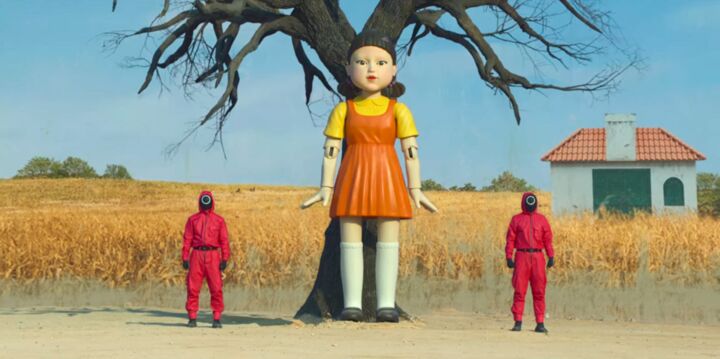
Squid Game, EP1. © Netflix.
Number 1 of the most viewed programs on the platform in more than 90 countries, this series halfway between Hunger Games, Battle Royale and the most obscure episodes of Black Mirror doesn't go unnoticed. Squid Game is the story of a clandestine competition where several hundred players compete in a series of deadly challenges, inspired by the traditional games of South Korean youth. Organized by a capitalist elite in search of thrills, all the events are accompanied by a particular aesthetic, confronting the joyful banality of the game with the cruel and threatening nature of its consequences.
Today, we're going to discover the different artistic references hidden throughout the series: Follow the guide!
1. René Magritte, an inspiration at the heart of the plot
Already benefiting from a particularly well brought global symbolism (allegorical colors and omnipresent geometrical forms), the series abounds in clues allowing the cleverest viewers to anticipate the next part of the scenario.
One of these precious clues went unnoticed by most viewers: it happens in episode 2, when the detective, Hwang Jun-ho, visits the uninhabited room of his mysteriously missing brother. This brother, as we will know later, is a key element of the plot: winner of a previous deadly competition, he'll become the cruel Frontman (the Game Master with the black mask).
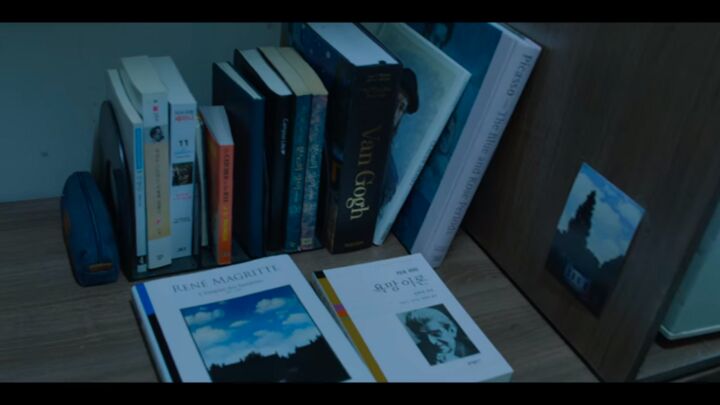
Squid Game, EP2. © Netflix.
While exploring the few clues in the missing man's room, just before discovering the geometrically shaped calling card that will put him on the trail of the Squid Game, the inspector discovers his brother's personal library. On the desk, a dozen books are arranged along the wall (a meager collection for a multimillionaire!). There's an anthology of artistic books: a book on the blue and pink periods of Picasso, a biographical book on Claude Monet, as well as a book listing all the artworks of Vincent van Gogh.
In front of this scanty display, two books are prominently displayed on the desk. It’s a book by the Parisian psychoanalyst Jacques Lacan (at right), and a monographic book on René Magritte, with one of the many versions of his popular artwork, The Empire of Lights, on the cover.
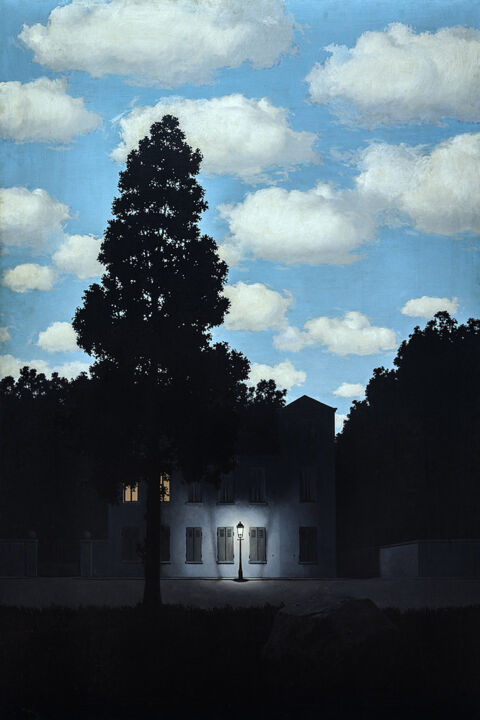
René Magritte, The Empire of Lights, 1953-54. Original Lithography available on Artmajeur.
But why these books? Why were these books arranged in this way? Simple coincidence or hidden message?
Obviously, in Squid Game, nothing is left to chance: these two books serve as clues to allow the most attentive viewers to make guesses as to the next step in the scenario. Jacques Lacan, the author of the book on the right, is a world-renowned psychoanalyst, especially for his studies on human desire and interdependence. An in-depth study of his writings would be particularly useful for anyone wishing to enslave hundreds of humans to a macabre fate. Clever, this game master!
But what is René Magritte doing in this sequence? It seems that the evocation of the greatest Belgian surrealist painter isn't random either, as evidenced by the (very) numerous appearances of his artwork "The Empire of Lights" in this same scene. Indeed, we find a reproduction of the artwork in postcard on the side of the library, then in a larger format on the other side of the desk, on which the inspector's gaze stops for several seconds.
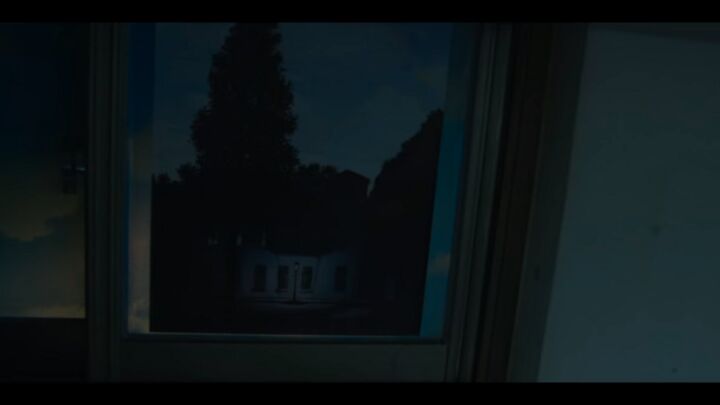
Squid Game, EP2. © Netflix.
The Empire of Lights is one of the greatest masterpieces of the Belgian surrealist genius, who produced 16 variations of it throughout his career. Its composition is a confrontation of day and night, a kind of collage disturbing the mind of the viewer by its material impossibility.
Its symbolic force is obvious: it is the coexistence of darkness and light, of good and evil, of the occult and the sacred. As if to testify to the internal evolution of a character, who goes from prey to executioner, from victim to persecutor, from fragile player to cruel supervisor. This artwork disrupts the fundamental organizing principle of life, while provoking confusion and unease.
If Squid Game was an artwork, it would be this painting.
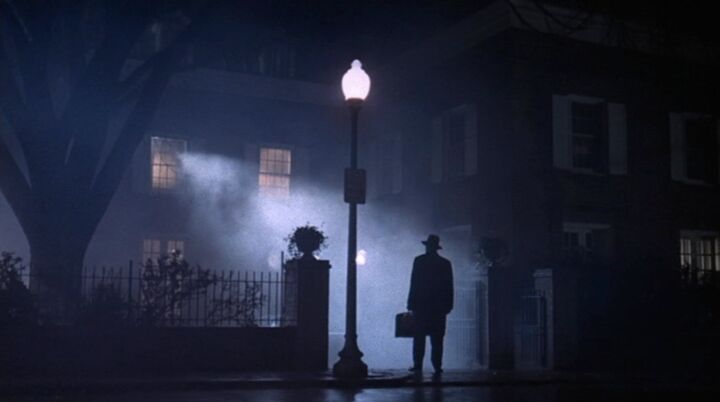
William Friedkin, The Exorcist, 1973. © Warner Bros.
This isn't the only reference to this enigmatic painting in the audiovisual world, since the famous movie The Exorcist (1973) was already inspired by this painting in a legendary scene, which was also used as a promotional poster: when the priest arrives near the MacNeil's house, illuminated by the powerful light of a streetlamp.
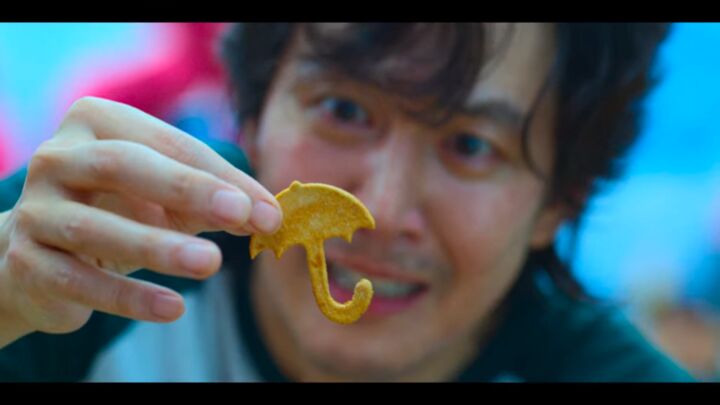
Squid Game, EP3. © Netflix.
And... this isn't the only reference to René Magritte in the Netflix series, since it regularly pays homage to him, more or less discreetly. For example, in the test consisting in cutting geometric shapes in a kind of sugar paste (the Dalgona Candy), we notice the presence of a symbol inherited from the Magritte’s Universe: the Umbrella. In the traditional version of this game, no shape is imposed: this is a voluntary choice of artistic direction.
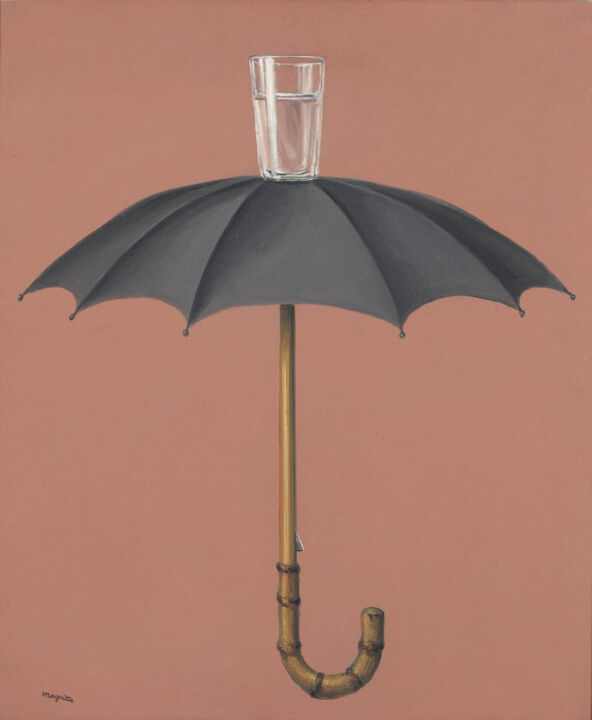
René Magritte, Hegel's Holiday, 1958. Private Collection.
In the same spirit, the wall decorations of the game rooms, often composed of blue skies and white clouds, strongly recall the minimalist and childlike skies of the Belgian painter. Magritte's surrealist universe is present at every moment.
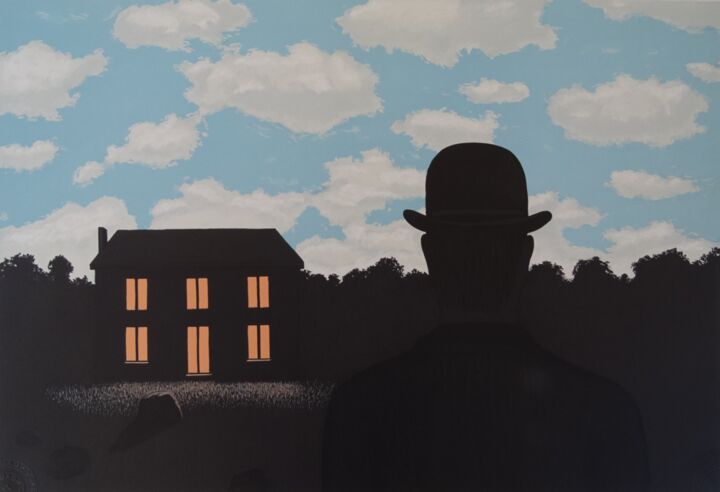
René Magritte, The Empire of Lights (Variation), 1964-65. Original Lithography available on Artmajeur.
2. A special mention to M.C. Escher's masterpiece.
Do you remember those endless colored stairs where our favorite players move in single file, like ants, to reach the different game rooms? Well, these endless ramps are directly inspired from an engraving by the Dutch artist Maurits Cornelis Escher, entitled Relativity.
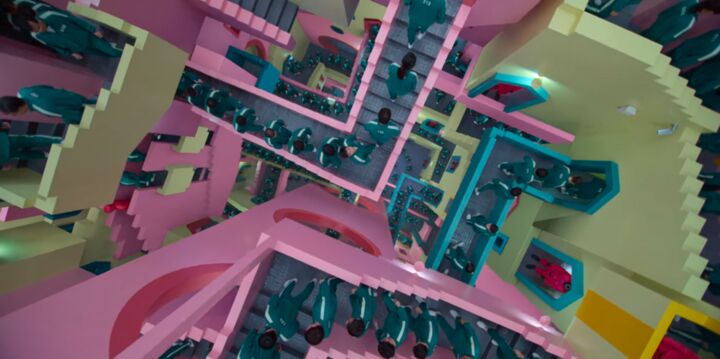
Squid Game, EP1. © Netflix.
This artist, born at the very end of the 19th century, fascinated the world with engravings illustrating complex mathematical notions and impossible objects (Necker cube, Penrose triangle…).
By manipulating the perspective in his drawings, he realized incredible trompe-l'oeil, until he became an uncontested master of the genre.
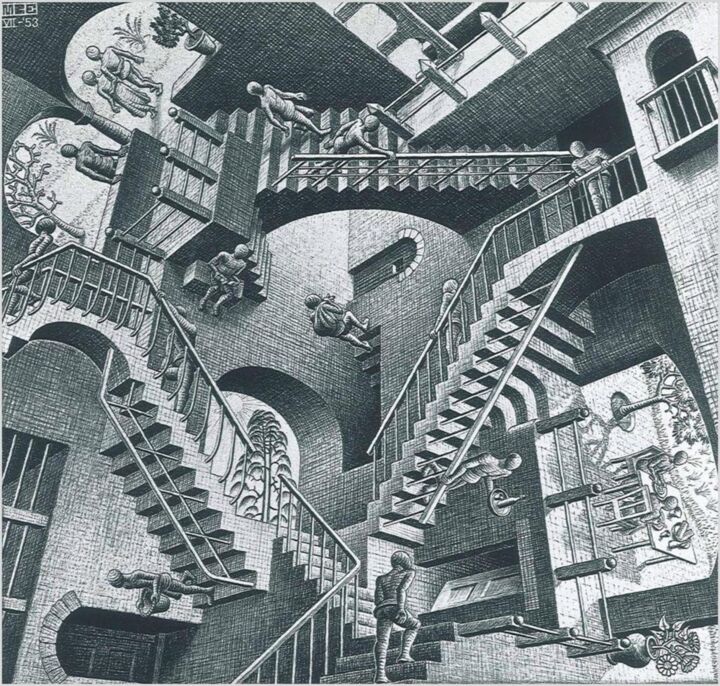 M.C. Escher, Relativity, 1953.
M.C. Escher, Relativity, 1953.
Here, the reference is clear: the tortuous staircases and the characters with banal forms reinforce the feeling of resemblance. The artistic directress of the show confirmed in an interview that she was clearly inspired by M.C Escher to conceptualize this space.
3. An occult and eccentric elite inspired by a surrealist ball
On the side of the super-villains too, the series doesn't lack mysteries. If you too have been disturbed by these VIPs, a wealthy elite hidden under golden masks, then hold on tight, because their secret meeting and strange disguises are inspired by a very real event: the Surrealist Ball of Marie-Hélène de Rothschild.
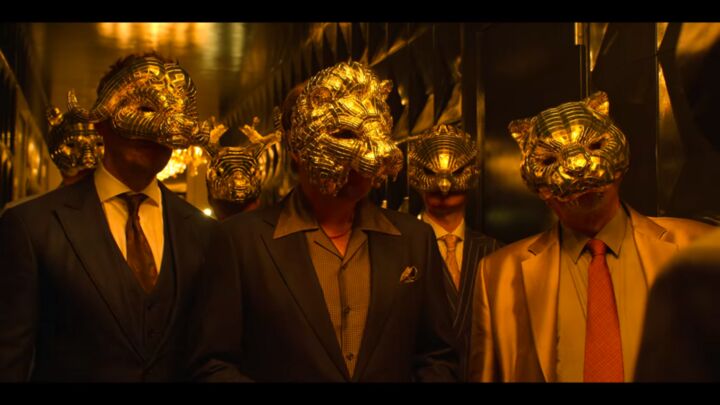
Squid Game, EP7. © Netflix.
Marie-Hélène de Rothschild was a wealthy French heiress, patron of the arts and close to the famous surrealist artist Salvador Dali. She organized several balls in the Château de Ferrières, a huge fort near Paris. On December 12, 1972, she invited many rich, powerful and influential people from around the world (including Audrey Hepburn, Dali and many members of the Rothschild family).
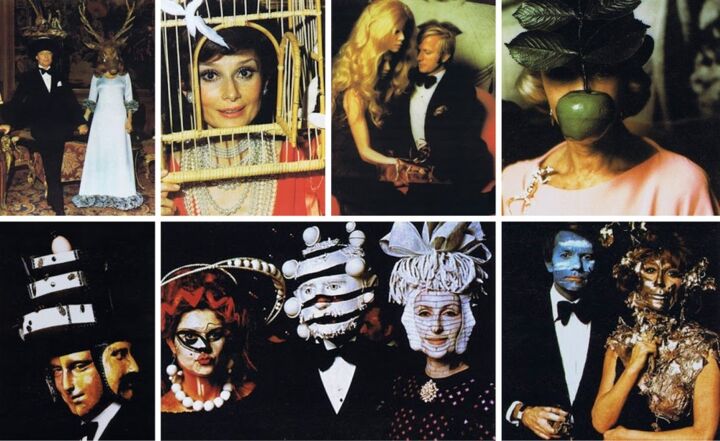
The Rothschild Surrealist Ball, 1972.
The decoration of the mansion was entrusted to Salvador Dali, and the guests were obliged to dress up according to the theme of the evening: Surrealism. We let you see the result in pictures: a macabre evening, with masks and costumes all more disturbing than the others. Special mention for the host, Marie-Hélène de Rothschild, who wears a deer mask set with diamonds in the shape of tears.
Does this remind you of anything? Are you uncomfortable? So are we!
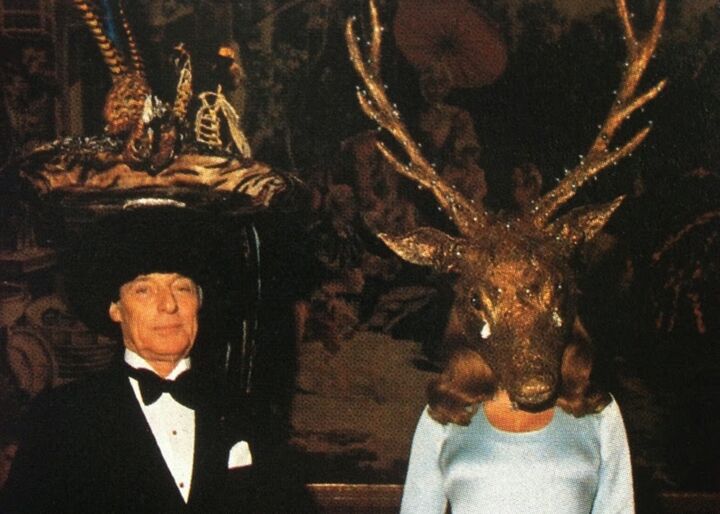
The Rothschild Surrealist Ball, 1972.
The macabre disguises and the occult atmosphere of this evening inspired Stanley Kubrick for his film Eyes Wide Shut, which he directed a few months before his death. A conspiracy rumor claims that his death was linked to the worldly secrets he might have disclosed in this film. In any case, there's no doubt: the art direction of Squid Game was inspired by the surrealist ball and Stanley Kubrick's film to design the animal masks worn by these odious capitalists.
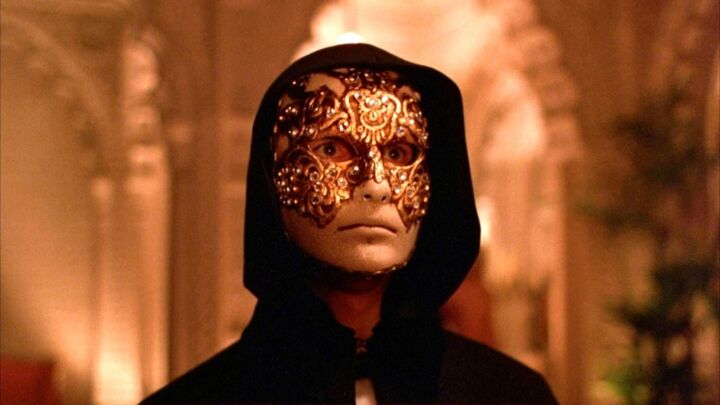
Stanley Kubrick, Eyes Wide Shut, 1999. © Warner Bros.
And that's it, this ranking is over. We can't wait for a second season to be able to enjoy new scenaristic subtleties!
If you're interested in artistic references in fictional works, don't hesitate to consult our articles: When Cinema Pays Tribute to Art History Masterpieces, the 10 Best Artistic References in Famous Anime Series, and When Comics Pays Tribute to Art History Masterpieces. And if you love the Magritte's universe, Discover our original lithographies on sale on Artmajeur.

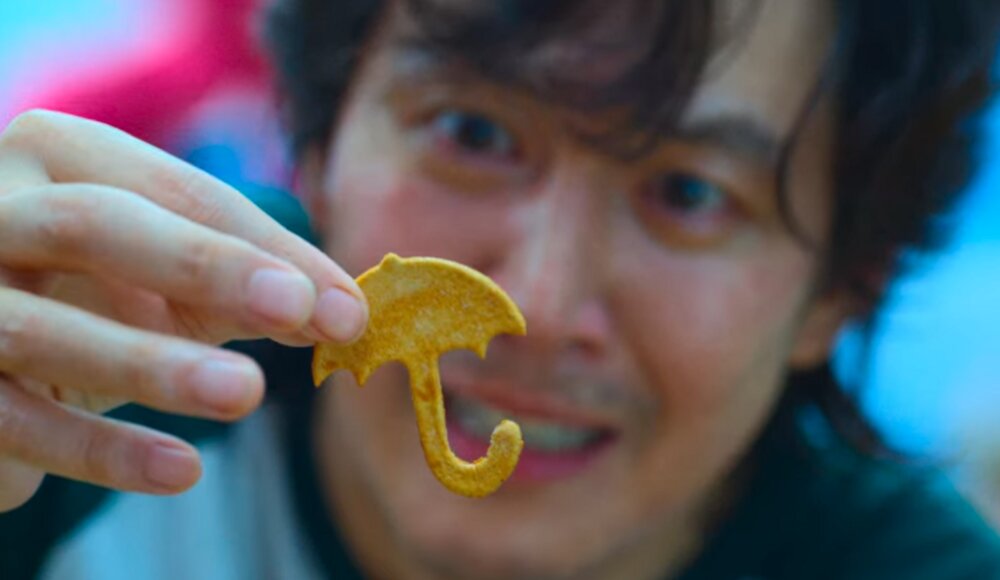
 Bastien Alleaume (Crapsule Project)
Bastien Alleaume (Crapsule Project)